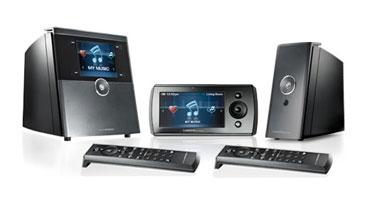Linksys By Cisco

| The Short Form |
| $999 ($1,078 as tested) / Linksysbycisco.com |
| Snapshot |
| Linksys's entry into the world of wireless audio systems will easily - though not always reliably - stream music throughout your home, and it comes with a very slick touchpanel controller |
| Plus |
| • Super-intuitive Controller • Director has LCD screen for local control • Allows iPod integration and control |
| Minus |
| • Occasional audio dropouts • Random, frustrating lockups • Plasticky, lightweight-build quality • Limited battery Life on Controller |
| Key Features |
| • Premiere Kit Bundle ($999) includes DMC250 Director, DMP100 Player, DMRW1000 Controller and 2 DMRIR500 infrared handheld remote controls • Director: 6 3/8 x 7 x 5 ¾ in, 3 3/8 lb; • Player: 5 3/8 x 5 ½ x 2 3/8 in, 1 ¼ lb; • Controller: 3 3/8 x 6 7/8 x 1 in, 3/8 lb • DMC250 includes 50-watt stereo digital amplifier • MRW1000 Controller 4 ¼-inch widescreen color display shows metadata, including album art • Includes 30-day Rhapsody trial subscription • System supports WI-Fi draft dual-band 802.11n and 801.11b/g standards • Optional MCC140 wired iPod Docking Station ($79) • Additional Players cost $299, Director $449, and Controller $350 |
Music is supposed to be able to calm the savage beast. So it should go without saying that a system that can distribute music throughout the home is something many people would want. Until recently, that prospect meant difficult retrofitting and stacks of complex gear. Fortunately, wireless technology has come to the rescue, with several companies now offering products that easily beam music from one room to another.
One of the big audio announcements at the 2009 Consumer Electronics Show was a new offering from Linksys by Cisco called the Wireless Home Audio system. Linksys is a networking technology leader, so it seemed obvious that it would know how to handle the task of moving packets of digital music from Point A to all points beyond. While the system's individual components can be purchased a la carte, they are also offered in several price saving bundles. We chose to review the Premiere Kit, which includes the DMC250 Director, DMP100 Player, DMRW1000 Controller, and two DMRIR500 infrared remote controls. Linksys also sent its optional MCC140 iPod docking station.
While Linksys would never say so, many attendees at CES had dubbed this system "The Sonos Killer," which greatly added to its intrigue for me. Sound & Vision awarded the original Sonos system an Editor's Choice Award in 2005, and I was duly impressed with the latest version I tested in 2008 (the Sonos Bundle 150). So it only seemed fitting that I should audition the Linksys system to determine if we needed to clear the throne for a new king.
Setup
Each Linksys component comes with a Quick Installation Guide that offers little of value beyond pictures of the unit's front and back, and a possible connection diagram. Actual configuration of the system requires running the included LELA (Linksys EasyLink Advisor) setup CD on your computer.
Once you've installed LELA, it guides you through the process of adding and configuring each component. This involves connecting them directly to your router using an Ethernet cable, naming them (Living Room, Theater, and so on), and then configuring the system for Wi-Fi operation. The system rides on whatever Wi-Fi is present in the house, supporting draft dual-band 802.11n as well as the more common b and g standards. During my setup, I was unable to configure the DMRW1000 controller using LELA, even after a call to tech support. Fortunately, I was able to manually add it to the system by following the Setup instructions on the touchscreen itself.
Another part of setup involves telling LELA the folder where your music is stored, whether directly on your computer or on anther networked drive. Once that's done, those files are then available for streaming to the system. All of the most common file formats (WMA, MP3, WAV, AIFF, FLAC, AAC, and AAC+ files) are supported. The two biggies not supported are the WMA and Apple lossless formats.
The DMP100 Player, which is devoid of any controls or a display, is meant for connecting either to powered speakers or to an existing home system. It features both stereo analog and optical digital audio outputs, along with a stereo analog input for a local source like a cable box or a satellite-radio tuner. Connected analog sources are available globally, meaning that they can be accessed from any other zone in the house - a big plus.
With its 3 1/2-inch color LCD screen and quartet of control buttons, the DMC250 Director is far more functional and cooler to look at than the Player. (Still, both units are cased in a plastic housing that feels kind of insubstantial.) Another major difference is that the Director includes a 50-watt stereo amplifier for driving speakers, making it a perfect option for secondary rooms. The Director has the same jacks offered by the Player but adds a USB port, a connector for the optional iPod dock, and a subwoofer output. Both components include a 1/8-inch headphone output - a nice touch that enables discreet late-night listening.
With its glossy black finish and 4 1/4 -inch, 480x272-resolution widescreen display, the DMRW1000 Controller kind of resembles a Sony PSP. With only a scroll wheel and two buttons - one that calls up a volume-adjustment bar and a Home button that toggles between the main menu and the Now Playing screen - the Controller's layout is clutter-free.
- Log in or register to post comments




































































